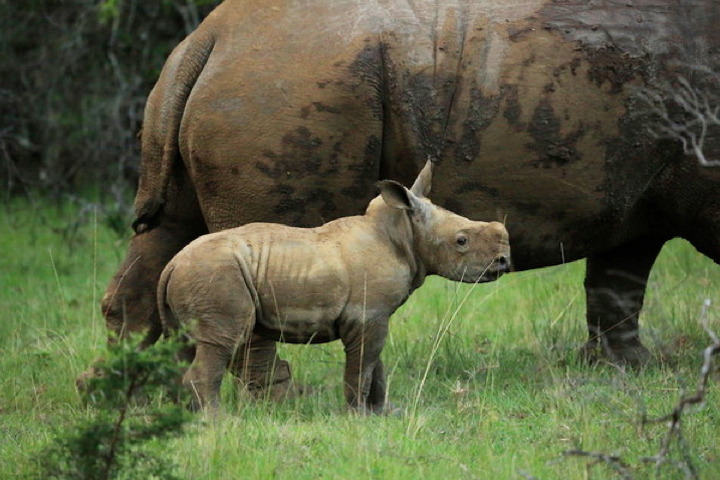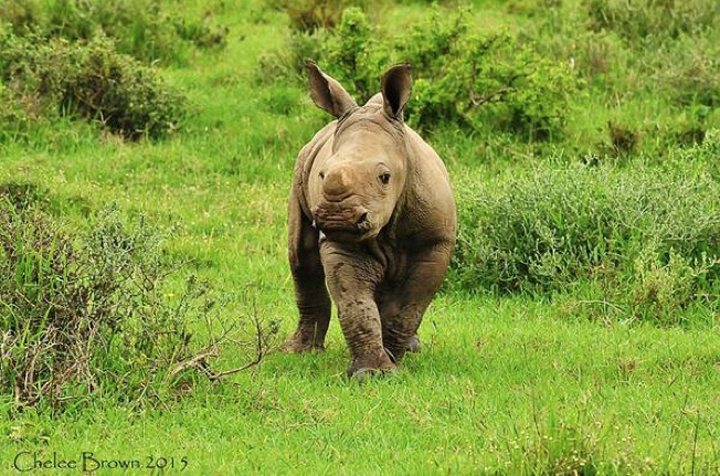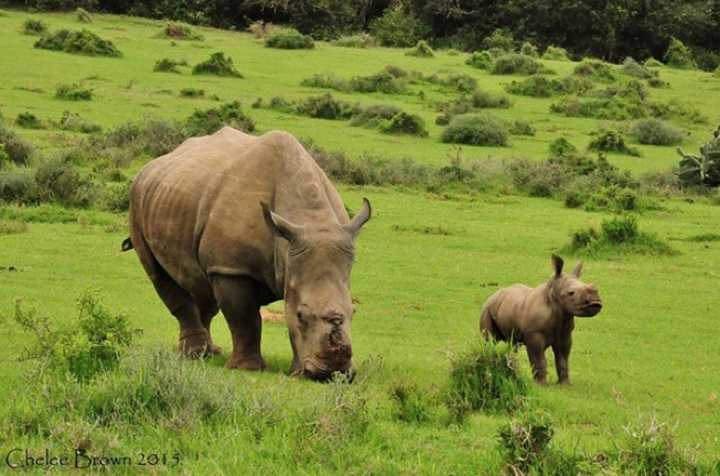Baby Rhino Beats The Odds… And The Poachers
Conservationists are cheering the birth of a little white rhino whose mother, Thandi, recovered from a brutal attack by poachers. In the war to save rhinos, every survivor counts.
By Vicki Croke
Hope for a species: Against all odds, this healthy baby white rhino was born last month at Kariega Game Reserve. Photo: Chelee Brown. Courtesy of Kariega Game Reserve.
She’s just a month old—all ears and knobby legs connected by a tank of a body. This baby white rhino in a game reserve in South Africa doesn’t have a name yet, but she has people all over the world rooting for her. And with good reason.
In the fight to save rhinos, there are moments when hope transcends the devastation. The birth of this one little “miracle” white rhino calf a few weeks ago is a perfect example. By all odds, she should never have been conceived, never mind born.
Thandi survived a brutal attack by poachers three years ago, was nursed back to health by a skilled veterinarian, and is now a protective mother. Photo: Chelee Brown. Courtesy of Kariega Game Reserve.
That’s because three years ago, in the Kariega Game Reserve in South Africa’s Eastern Cape province, her mother, Thandi was attacked by poachers in a horrific, and unfortunately, common kind of assault. The criminals darted her with a tranquilizer—perhaps M99, which is a thousand times more potent than morphine, and popular with these thugs. The poachers certainly don’t do it to be kind—in fact, in their hands it is usually deadly, but it is quieter and requires less accuracy than bullets fired from guns. Following common practice, they cut deeply into her flesh to remove her horn, and left her for dead. Two male rhinos who were also wounded in the same attack did not survive.
When Thandi was first found, she was lying in a pool of blood and was barely alive. She was breathing only through holes in her skull, according to wildlife veterinarian Will Fowlds of Investec Rhino Lifeline, who led the efforts to save her. And over three years, she endured many procedures, including four pioneering skin grafts. They worked.
And Thandi did her part. Despite the constant interruptions of medical care and surgeries, she resumed, whenever possible the life of a normal rhino on the reserve. That point was driven home when routine blood tests in December 2013 revealed that she was pregnant.
[youtube=http://youtu.be/c8GL7zW1l8A]
“My greatest rhino day ever! Seeing Thandi’s calf for the first time, up close and in the open, un-phased by our existence and positively adorable will always rank as a highlight in my life. We sat there quietly soaking up the privilege of being in their presence, and… it…was… amazing.” -Wildlife vet Dr William Fowlds. Video by Paul Mills. Courtesy of Kariega Game Reserve.
The gestation period for rhinos is about 15 to 16 months. And on January 13, 2015, two rangers at the reserve witnessed the birth and immediately called Dr. Fowlds in. Thandi led her female baby deeper into a section of the reserve that is now off limits to visitors. The Reserve is working to keep the animals safe—fitting them with tracking devices and employing a protection unit of armed guards. Some rhinos at the reserve have even had their horns removed in an effort to keep them safe from poachers.
All of the caution is necessary in the face of unprecedented slaughter and poaching of rhinos for their horns.
According to The Guardian:
Poaching is driven by the growing market for rhino horn in ever-more affluent East Asia. The horn is primarily made out of a material similar to keratin – the stuff that makes up hair and fingernails. It has been used in traditional Asian medicine for centuries. The now mostly extinct or endangered Asian rhino species were hunted because of a misbelief their horn could treat fever and cerebrovascular disease.
In recent years rhino horn has been endowed with further fantastical properties that treat cancer and cure hangovers. The common notion that rhino horn is used as an aphrodisiac in Asia is derogatory and untrue, according to wildlife trade observers Traffic. However, a recent survey that found evidence the belief was prevalent in Chinese society.
The latest statistics tell a grim story.
According to Jason G. Goldman, reporting in Scientific American, the killing is increasing at an astonishing rate:
In 2014 the South African government counted 1,215 rhinos that met their deaths at the hands of poachers. The final number will almost certainly increase as more data arrives. Whatever the total, it means that more than 1,200 rhinos needlessly were killed for their horns—tapered shafts of keratin, the same stuff that’s in your fingernails. The count, once finalized, will be about twice as many animals as were killed in 2012 and over a thousand more than were poached in 2008, which marked the real start of the rhino poaching crisis. The total population of African rhinos is estimated at about 25,000.
And the perpetrators are determined, well-armed, and sophisticated. Scientific American reports:
Rhino horns can sell for $60,000 to $100,000 per kilogram, making them, in addition to elephant ivory, which sells for around $3,000 per kilogram, an attractive funding source for terrorist militias in Africa such as the Janjaweed, the Lord’s Resistance Army, al Shabab and Boko Haram. These poachers are well funded criminals with access to some of the highest-tech, most powerful tools that allow them to quickly find and tranquilize an animal, lop off its horn (and often some of the rhino’s face with it) while the animal is still alive, then quickly escape, leaving the rhino to slowly die as the anesthetic wears off. If the mutilated animal is lucky, it might be found quickly and euthanized by wildlife officials.
South Africa has the largest population of rhinos in the world. And Thandi and her baby, indeed, represent hope for a species under immense fire.

Thandi’s baby will be named in a ceremony next week. Photo: Paul Mills. Courtesy of Kariega Game Reserve.


